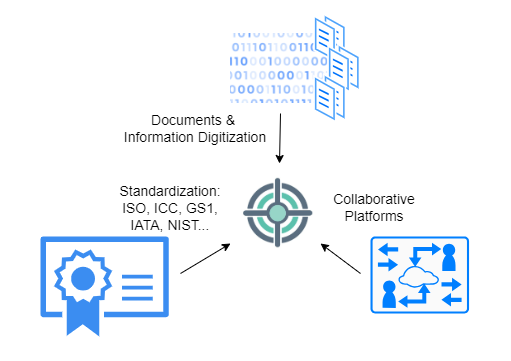Standardized Information Sharing in Supply Chain Management
Effective standardized information sharing relies on three key pillars: digitization documents, collaborative platforms, and standardization of doc...

Introduction:
In supply chain management, effective standardized information sharing relies on three key pillars: digitization of documents and information, utilization of collaborative platforms, and standardization of documents and information formats. Each of these pillars is essential, as they collectively contribute to ensuring secure, fully digital collaborative document and information exchange capabilities.

Below are detailed descriptions of each of the pillars, along with examples of what a good framework for standardized information exchange should look like:
.
Documents & Information Digitization: Proper digitization and availability of documentation are paramount for shipments to arrive on time. While many documents are digitized, achieving a unified view of all documents in a uniform and timely manner remains a challenge:Documents Digitization:
Information Digitization:
Timely Digital Recording of Information:
.
Documents & Collaborative platforms Once information is digitized, procedures must be established regarding what information should be shared and who should have the privilege to view it. The process of sharing should be flexible, transparent, and, above all, secure. Below are items that need to be considered:Collaborative platforms configuration:
Flexible, secure, and auditable access control for granting and removing access to shared information based on:
Data protection and privacy laws:
Immutable and auditable store of records:
.
Standardization of Documents & Data Elements: Finally, the standardization of documents, along with the identification and classification of standardized data elements, is pivotal for achieving a consistent representation of vital information commonly found in documents used across supply chain management.Another standard related to interoperability of operational data is the GS1 Business Vocabulary, which provides standardized identifiers, codes, and attributes for describing products, locations, parties, transactions, and more.
Notable efforts by the ICC through its Digital Standards Initiative project and the GS1 Business Vocabulary lay the groundwork for standardizing document data, providing a fundamental framework for enhanced interoperability and efficiency in supply chain operations.
The International Chamber of Commerce:
GS1:
.
Conclusion:
As supply chain management becomes increasingly complex and trade volumes rise, securely and timely sharing information between various stakeholders becomes imperative. In this era of leveraging Artificial Intelligence, including machine learning and intelligent automation, the initial step is to digitize supply chain management, thereby implementing frameworks that enable data standardization and secure access between parties.
The above three pillars should serve as guidelines for supply chain management parties to understand the necessary capabilities required to enable frictionless digital collaboration.